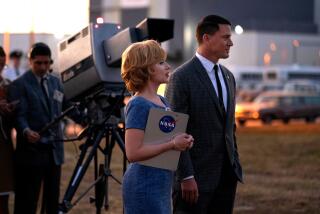Houston, We Have a Problem
- Share via
In naming Sen. John Glenn to the Discovery crew, the National Aeronautics and Space Administration demonstrated that it is ready to return to the entertainment business. The audience for the Oct. 29 launch doubtless will be Princess Di-sized. A troubled agency, saddled with an increasingly controversial mission (the international space station) and comically unreliable partners (the Russians), will likely get a much-needed boost in popularity.
But is stunt-casting the best way to decide national science policy?
The space program began as spectacle, with heroes, high drama and huge television ratings, which NASA shrewdly used to build political support. But ever since the end of the Apollo program, NASA has had to struggle to capture the attention of Americans. Once the space shuttle became routine, it became invisible.
It took the naming of New Hampshire teacher Christa McAuliffe to the 1986 Challenger mission to get the nation to notice NASA again. The media loved it. It captured the country’s imagination. And we understood our role as audience perfectly. When Challenger reached Max Q, the moment of maximum aerodynamic stress, we were supposed to hold our breath, then release it, as the spacecraft headed triumphantly toward the heavens.
When, instead, it exploded, the illusion of watching something scripted was wrenched from viewers so violently that it was traumatically disorienting. Commingled with grief was bewilderment, a kind of ontological dislocation. Could this really be happening?
Twelve years later, NASA has found the confidence to try again, choosing from the aging astronaut corps the one with star power. Already Glenn has chastised reporters for dwelling on his fame and personality rather than on geriatric space science, a complaint frequently voiced by celebrities who lend their presence to worthy causes. Now Mission Control is wrestling with the propriety of saying “Godspeed, John Glenn” when the shuttle clears the tower, the same bon voyage he was offered on his Mercury flight; it would make for wonderful theater. But what about the other crew members on board? Godspeed to them, too? NASA has billing issues just like Disney.
In an information age, the scarcest commodity is attention. Increasingly, the goal of every human enterprise is capturing eyeballs. The means most often employed is entertainment. It is as true of high culture as of commerce. The professor, the museum curator, the news director, the minister and the studio executive all want the same thing: customers. We experience life itself as a show, as theater. A room isn’t a room; it’s a stage set. A store is theme park. Politics is performance. A constitutional crisis is a soap opera.
Before Glenn was named to the Discovery manifest, I wrote a story called “Max Q” for Disney about beleaguered NASA’s attempt to win support for its budget by putting a reporter on board; the movie will air a few days after Glenn’s return. In the plot, the price NASA pays for tempting a rerun of Challenger is a terrible accident. The risk of catastrophic failure on Glenn’s mission is 1 in 145, an outcome known only to God; the risk in “Max Q” is ordained by the script, and the genre’s demand for happy endings. Who can blame the millions who will watch Glenn’s launch, like the millions who watched Challenger, for confusing theatrical suspense with real jeopardy?
The country faces some difficult questions about science policy. Does the space station still make sense? Is the shuttle obsolete? Is its science worth its cost? Why send astronauts into space when robots cost so much less? The power of entertainment, as Plato warned, turns audiences into putty. No doubt lots of serious cross-talk will be devoted to these policy topics. But the winning side of those fights is always the one with the hero.
More to Read
The biggest entertainment stories
Get our big stories about Hollywood, film, television, music, arts, culture and more right in your inbox as soon as they publish.
You may occasionally receive promotional content from the Los Angeles Times.










